Welcome to the fascinating world of birds in the North West! This region of the United States is home to various birds that make their homes here, from the majestic bald eagle to the more common robin.
Many species of birds migrate through this region, making it a great place to observe various species. This guide will provide an overview of some of the birds found in the North West, including their behaviors and habitats.
We hope you enjoy learning about these incredible creatures and maybe even spot one during your next visit to the North West.
24 Birds to Watch in North West
With diverse ecosystems ranging from lush forests to sprawling grasslands, the West offers a rich tapestry of avian life waiting to be discovered.
With its diverse habitats and strategic location, this region serves as a haven for a wide array of bird species, making it a haven for birdwatchers and nature enthusiasts.
Here are 24 Birds to Watch in the West.
1. Northern Flicker
The northern flicker, also known as the familiar flicker, is a bird from the woodpecker family. It is widely distributed across North America and parts of Central America, Cuba, and the Cayman Islands.
This woodpecker species stands out from other birds as it is one of the few migrating birds.
It is a medium-sized bird that readily stands out due to its distinctive coloration, consisting of a mostly brown body with a white rump and a black tail with white spots. Its head is primarily grey, with a red patch on the back. Its diet consists of insects, fruit, and grains.
The northern flicker is also distinguished by its songs and calls, which are often described as rattle-like sounds. It is a widespread species, making it a famous bird to observe.
| Kingdom | Animalia |
| Phylum | Chordata |
| Class | Aves |
| Order | Piciformes |
| Family | Picidae |
| Genus | Colaptes |
| Species | C. auratus |
2. Downy Woodpecker
The Downy Woodpecker is a species of woodpecker that is the smallest in North America. It is typically between 14 and 18 cm in length.
The Downy Woodpecker is found in forests across the United States and Canada, except in deserts in the southwestern and northern tundra regions.
The Downy Woodpecker has a black and white barred pattern on its back and wings and a red patch on its head. It also has a white belly and black wings. This species habitually drummed on trees and branches to make cavities for nesting and foraging.
The Downy Woodpecker is omnivorous, eating various seeds, nuts, fruits, insects, and even sap from trees. It is also known to eat suet from bird feeders.
It tends to forage on the trunks and limbs of trees, often hopping up and down the tree and clinging upside down to reach food. The Downy Woodpecker is a social species frequently seen in pairs or small groups.
During the winter months, flocks of Downy Woodpeckers can be seen as they flock together for protection and warmth. During the breeding season, they are territorial and will defend their territory against intruders.
Overall, the Downy Woodpecker is an important species of woodpecker found in North America. Its small size and unique markings make it a popular bird to watch, and its diet of seeds, nuts, insects, and sap makes it an important part of the forest ecosystem.
| Kingdom | Animalia |
| Phylum | Chordata |
| Class | Aves |
| Order | Piciformes |
| Family | Picidae |
| Genus | Dryobates |
| Species | D. pubescens |
3. American Robin
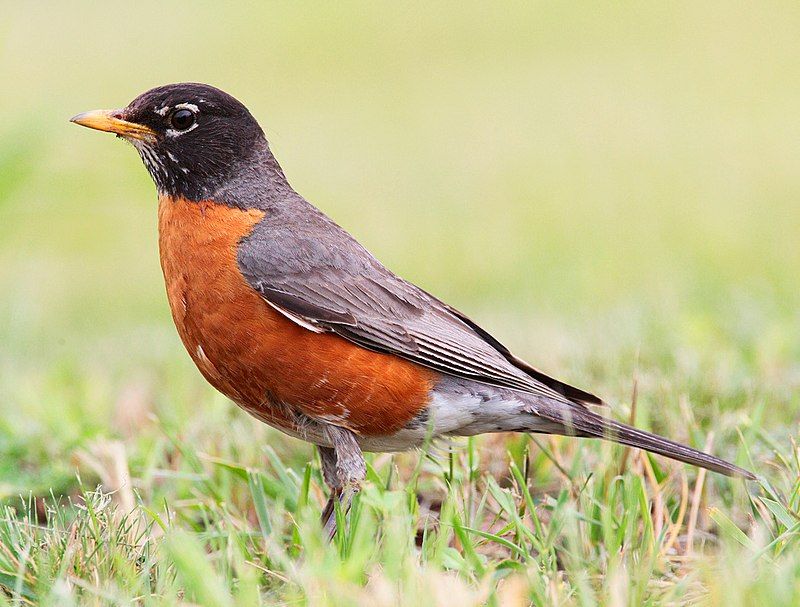
The American robin is a migratory bird that belongs to the valid thrush genus and Turdidae, which is a more prominent family of thrushes. It is named after the European robin because it has a reddish-orange breast, just like the European robin.
However, the two species are not closely related at all. The European robin belongs to the Old World flycatcher family. This means they may look similar due to the reddish-orange breast, but they are not genetically related.
The American robin is a migratory bird, meaning it moves from place to place during different times of the year, while the European robin is a permanent resident of its home area.
| Kingdom | Animalia |
| Phylum | Chordata |
| Class | Aves |
| Order | Passeriformes |
| Family | Turdidae |
| Genus | Turdus |
| Species | T. migratorius |
4. American Goldfinch
The American goldfinch is a small bird that lives in North America and belongs to the finch family. This bird species is migratory, meaning they travel to different places throughout the year.
During the breeding season, they can be found in an area that stretches from mid-Alberta to North Carolina. When winter arrives, they migrate to regions just south of the Canada–United States border down to Mexico.
This type of bird can thus be seen in various parts of North America, depending on the season.
| Kingdom | Animalia |
| Phylum | Chordata |
| Class | Aves |
| Order | Passeriformes |
| Family | Fringillidae |
| Genus | Spinus |
| Species | S. tristis |
5. Mourning Dove
The mourning dove is a member of the Columbidae family, which includes all types of doves. It is native to North America and is also known as the American mourning dove, the rain dove, and colloquially as the turtle dove.
In the past, it was named Caronamesgeon and CPigeona turtledove. The tturtledovedove is a medium-sized bird approximately 30 cm long. It has a gray-brown body with black spots on the wings and tail, a black bill, and a white-tipped tail.
Its song is a loud, low-pitched cooing often heard at dawn and dusk. The mourning dove is a monogamous species, meaning that pairs usually stay together for life. The bird builds its nest on the ground in a shallow depression lined with grasses, twigs, and feathers.
The female lays two white eggs, which hatch after 14 days, and the chicks fledge after about another two weeks. The mourning dove is a common bird, often seen in open woodlands, fields, and suburban gardens. It feeds mainly on seeds but also eats some insects.
It is an important game bird whose meat is comparable to wild turkeys. The mourning dove is an iconic bird of North America, and its cooing call is familiar to many people.
It symbolizes peace and love and is often featured in art, literature, and music.
| Kingdom | Animalia |
| Phylum | Chordata |
| Class | Aves |
| Order | Columbiformes |
| Family | Columbidae |
| Genus | Zenaida |
| Species | Z. macroura |
6. House Finch
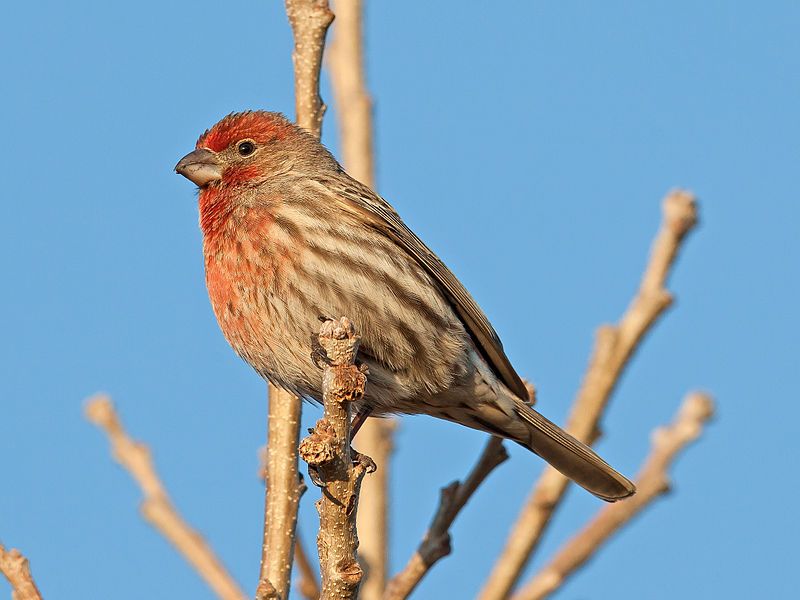
The house finch is a species of bird belonging to the Fringillidae family. It is native to western North America, from Alaska and Canada to Mexico, but has been introduced in other parts of the continent, such as the eastern USA and Hawaii.
The house finch is placed in the genus Haemorhous with the two other American rose finches. This genus comprises medium-sized passerines with conical bills, short tails, and sturdy legs.
The house finch has a brown or streaked upper body and a white, gray, or reddish-brown underside. It usually lives in open woodlands, near farmlands, and urban areas. The house finch is known to feed on grains, fruits, and seeds and is a frequent visitor to bird feeders.
Additionally, this species is an important seed disperser, which helps to maintain the health of the ecosystems it inhabits.
| Kingdom | Animalia |
| Phylum | Chordata |
| Class | Aves |
| Order | Passeriformes |
| Family | Fringillidae |
| Genus | Haemorhous |
| Species | H. mexicanus |
7. American Crow
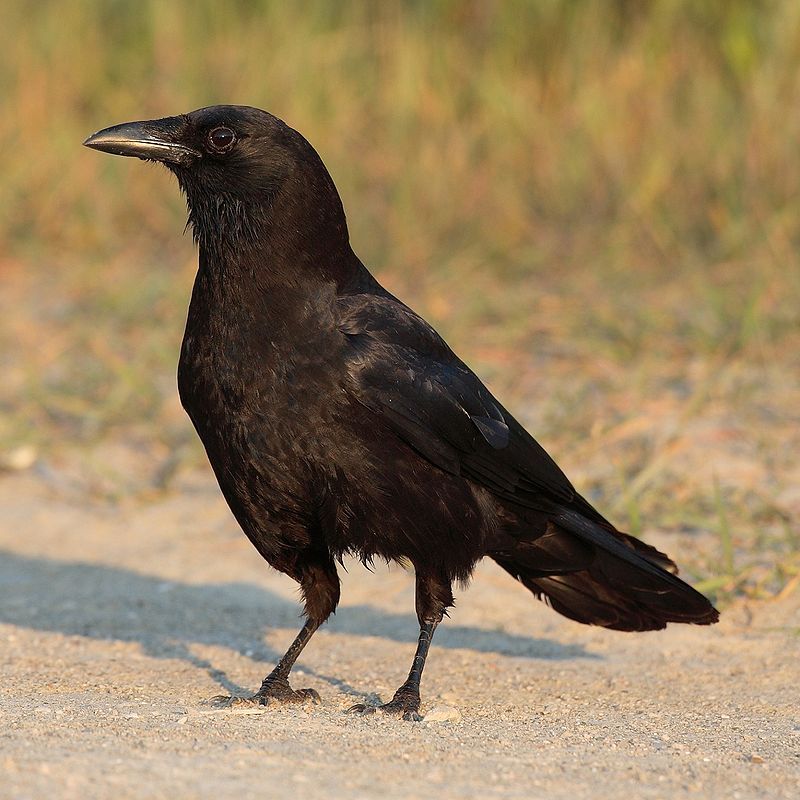
The American crow is a large passerine species in the Corvidae family. It is a widespread bird found in most parts of North America. The American crow is closely related to the carrion crow and the hooded crow of Eurasia.
All three species occupy the same ecological niche, meaning they share the same habitat and have similar behaviors and diets. The American crow is predominantly black, with a fan-shaped tail and a loud, distinctive call.
It is an omnivorous bird, feeding on various insects, invertebrates, fruits, and grains. It is also known to eat eggs, nestlings, and carrion. The American crow forms large communal roosts in winter and is known to be highly intelligent and adaptable to human environments.
| Kingdom | Animalia |
| Phylum | Chordata |
| Class | Aves |
| Order | Passeriformes |
| Family | Corvidae |
| Genus | Corvus |
| Species | C. brachyrhynchos |
8. Black-capped Chickadee
The black-capped chickadee is a small bird native to North America. It belongs to the tit family, or Paridae, and is a passerine bird, meaning it has an upright posture and perches. It cannot migrate and prefers to live in deciduous and mixed forests.
The black-capped chickadee is a prevalent bird and is the official state bird of Massachusetts and Maine in the United States and the provincial bird of New Brunswick in Canada.
Its popularity comes from its small size and friendly nature, as it is often seen around bird feeders and other backyard birdhouses.
The chickadee’s bright black cap and white cheeks make it easy to identify in the wild, and its cheerful song is always a welcome addition to any outdoor setting.
| Kingdom | Animalia |
| Phylum | Chordata |
| Class | Aves |
| Order | Passeriformes |
| Family | Paridae |
| Genus | Poecile |
| Species | P. atricapillus |
9. Song Sparrow
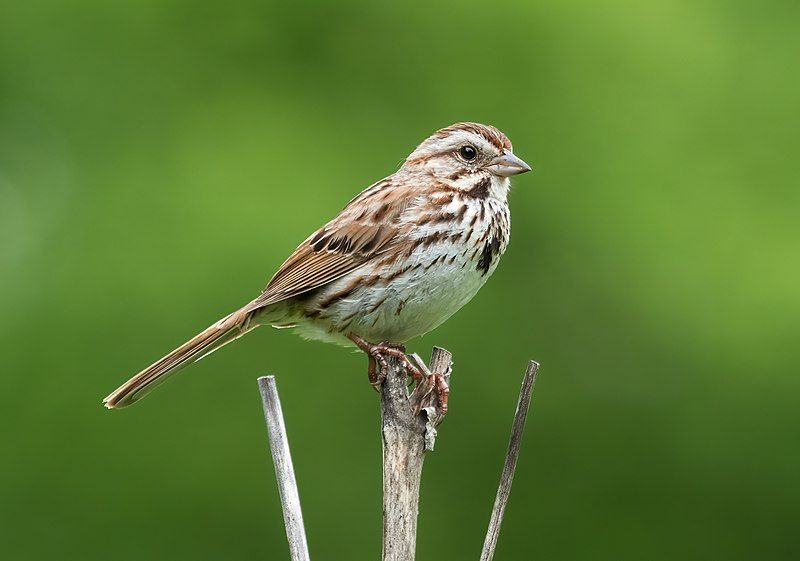
The song sparrow is a widely distributed species of bird found in the New World. It is a medium-sized sparrow with a length of around 16-18 cm and a wingspan of around 25-26 cm.
As a species, it is considered to be one of the most abundant, varied, and adaptable of all the native sparrows found in the North American region. The song sparrow can be found in various habitats, from open fields to woodlands, wetlands, and even urban areas.
It is highly adaptable to various conditions and can survive in multiple habitats. Its diet consists of a variety of seeds and insects. The song sparrow is a highly social species often seen in large flocks.
It is also known for its beautiful singing, which can be heard during the breeding season.
This species plays a vital role in the North American ecosystem, as it is an essential food source for many other species.
Overall, the song sparrow is a species that has a wide distribution, is highly adaptable and abundant, and is a vital part of many North American ecosystems.
Its beauty and song make it a joy to observe in its natural habitat.
| Kingdom | Animalia |
| Phylum | Chordata |
| Class | Aves |
| Order | Passeriformes |
| Family | Passerellidae |
| Genus | Melospiza |
| Species | M. melodia |
10. Anna’s Hummingbird
Anna’s hummingbird is a beautiful species of bird that belongs to the family Trochilidae. It is native to the western coastal regions of North America and is named after Anna Masséna, Duchess of Rivoli.
In the early 20th century, this hummingbird species was only found breeding in northern Baja California and Southern California. This species is a medium-sized bird with a length of 3.7-4.3 inches and a wingspan of 3.4-4.3 inches.
The male Anna’s hummingbird is usually bright green on the upper parts, with a greyish-white underside. The throat is usually a brilliant pink-red, while the tail feathers are generally dark grey.
Females of this species usually have a duller green on the upper parts, with a greyish-white underside and a dark grey tail. Both males and females have a straight black bill.
This hummingbird species is known for its territorial behavior, defending its food sources and nesting sites aggressively against other hummingbirds. It feeds on nectar from flowers and small insects and has been observed hovering near water sources to drink.
They nest in low shrubs or trees, and the female builds the nest from plant material and spider webs. The female incubates the eggs and cares for the young, while the male defends the nest.
Anna’s hummingbirds can be found in gardens and parks, often near water sources, and they can be seen feeding on flowers and chasing away other hummingbirds.
| Kingdom | Animalia |
| Phylum | Chordata |
| Class | Aves |
| Clade | Strisores |
| Order | Apodiformes |
| Family | Trochilidae |
| Genus | Calypte |
| Species | C. anna |
11. Northern Shoveler
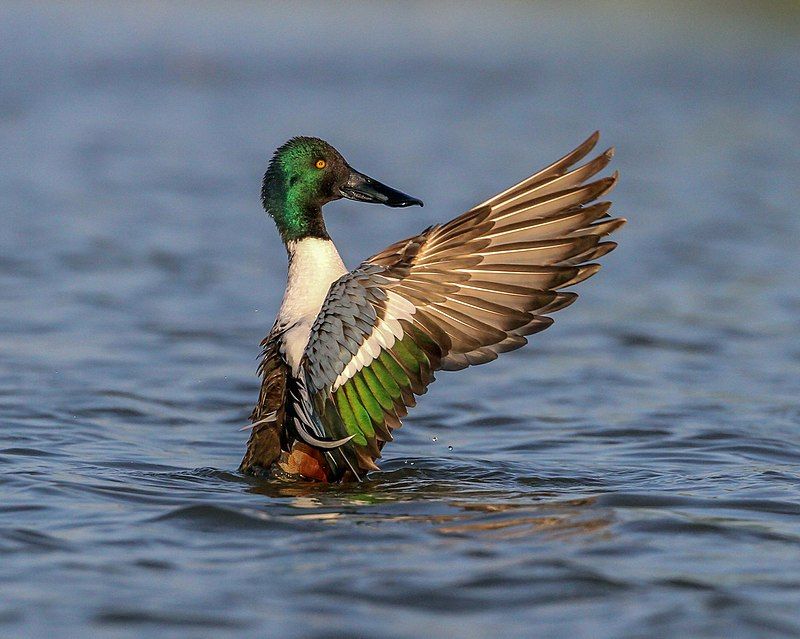
The northern shoveler, also known as the shoveler, is a widespread duck. Its main breeding grounds are located in the north of Europe and across the Palearctic region, stretching from Europe to Asia. It can also be found across most of North America.
During winter, this species migrates south, occupying parts of southern Europe, the Indian subcontinent, Southeast Asia, Central America, the Caribbean, and northern South America.
This species is well adapted to many habitats, from wetlands and marshes to grasslands and open water. Its diet consists mainly of aquatic invertebrates, such as insects, crustaceans, mollusks, and marine plant material.
The shoveler is a fascinating species, with its distinctive shovel-shaped bill and bright plumage. It is an essential species in many ecosystems, providing critical ecological services.
| Kingdom | Animalia |
| Phylum | Chordata |
| Class | Aves |
| Order | Anseriformes |
| Family | Anatidae |
| Genus | Spatula |
| Species | S. clypeata |
12. European Starling
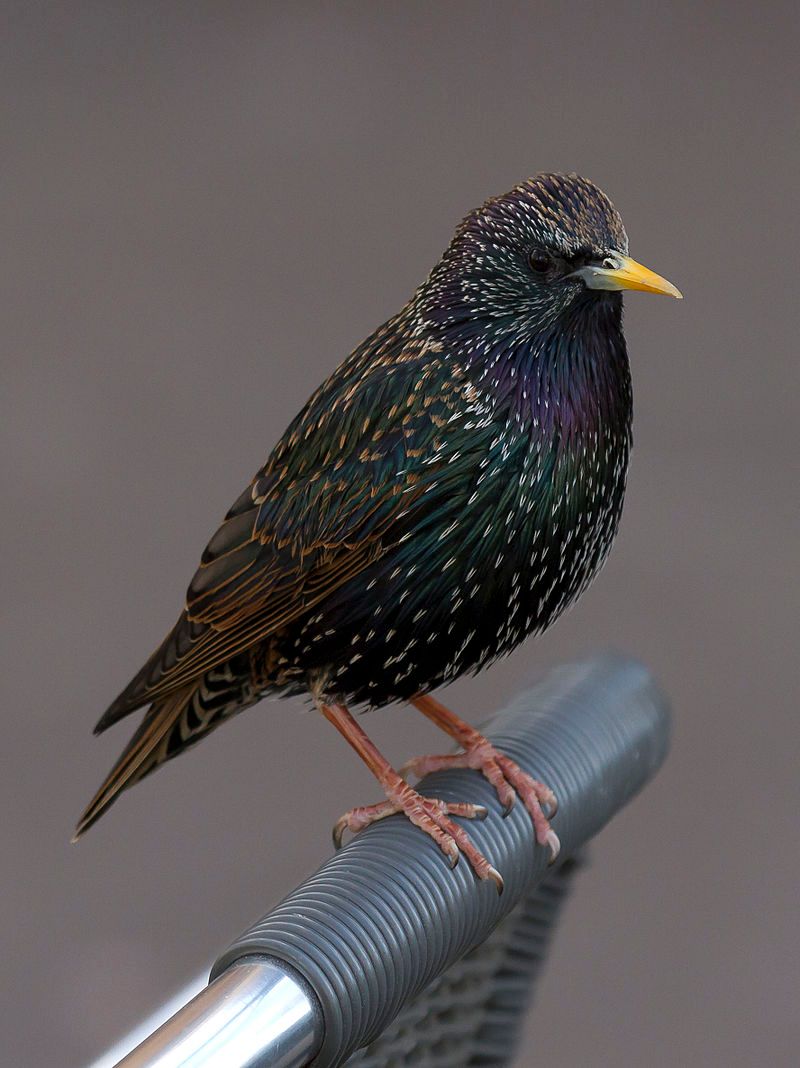
The common starling, also known as the European starling in North America and simply as the starling in Great Britain and Ireland, is a medium-sized bird in the Sturnidae family.
The Sturnidae family, commonly known as starlings, is a large group of passerine birds native to Europe, Asia, Africa, and the Americas. Common starlings are around 6.3-8.7 inches long and have a wingspan of 11-13 inches.
They have a black head and body, distinctive white spotting, and a yellow bill. The wings and tail are typically black, with white spots. Common starlings are highly sociable birds, often found in large flocks.
They are omnivores, eating various foods like insects, fruit, and grains. They prefer open habitats like grasslands, wetlands, and agricultural land.
They can also be found in urban areas, including parks and gardens. Common starlings are known for their vocalizations, with their songs composed of various whistles, chirps, and warbles.
They are also known for their spectacular aerial displays, which involve a group of birds flying in unison. Common starlings are a common sight in many parts of the world and a welcome addition to many gardens and parks.
| Kingdom | Animalia |
| Phylum | Chordata |
| Class | Aves |
| Order | Passeriformes |
| Family | Sturnidae |
| Genus | Sturnus |
| Species | S. vulgaris |
13. Spotted Towhee
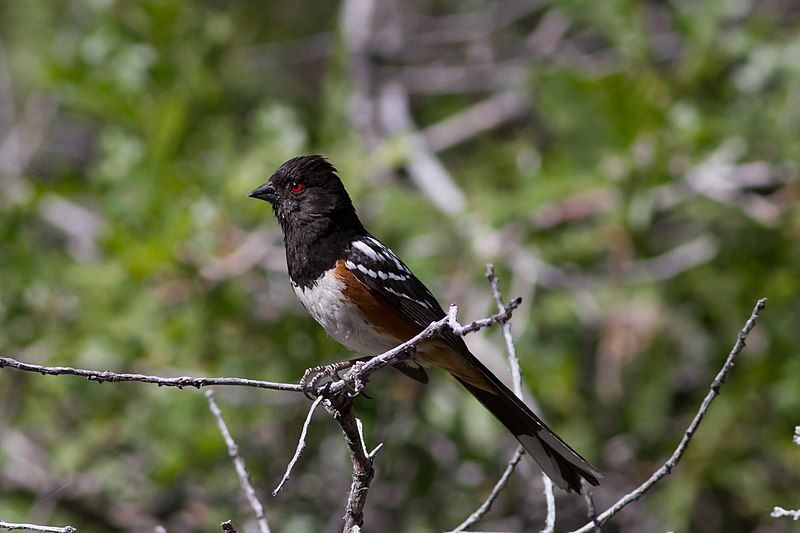
The spotted towhee is a member of the New World sparrow family and is more significant than most other species in this family. It has been the subject of debate among taxonomists in recent decades, as until 1995, it was thought to be the same species as the eastern towhee.
This combined species was known as the rufous-sided towhee. Another name that has since gone out of use is the Oregon towhee.
This reflects that the spotted towhee is often found in the western part of North America, whereas the eastern towhee is more likely to be seen in the eastern states.
The spotted towhee can be distinguished from other species in the family by its white belly, reddish-brown back, and wings. It has a single white spot on each side of its tail, which is the source of its name.
| Kingdom | Animalia |
| Phylum | Chordata |
| Class | Aves |
| Order | Passeriformes |
| Family | Passerellidae |
| Genus | Pipilo |
| Species | P. maculatus |
14. Cedar Waxwing
The cedar waxwing is a medium-sized passerine bird belonging to the Bombycillidae family, also known as the waxwing family. It is primarily brown, grey, and yellow and has distinctive yellow-tipped wings that give it its name.
These yellow-tipped wings are the most distinguishing feature of the waxwing and have a waxy appearance, hence the name. The cedar waxwing is native to North America and is found in temperate regions across the continent.
It is a friendly bird, often seen in small flocks foraging for food. It feeds mainly on fruit, berries, and insects, changing its diet with the seasons.
In summer, the waxwing can be seen in gardens and parks, feasting on seasonal fruits and berries. The waxwing is an active bird capable of hovering mid-air as it feeds.
It has a distinctive call, with a short, sharp whistle, and its songs are described as a mix of whistles and chirps. The cedar waxwing is a fascinating bird and a beautiful addition to any garden or park.
| Kingdom | Animalia |
| Phylum | Chordata |
| Class | Aves |
| Order | Passeriformes |
| Family | Bombycillidae |
| Genus | Bombycilla |
| Species | B. cedrorum |
15. Northern Pintail
The pintail or northern pintail is a species of duck found in various geographic locations. It breeds in the northern parts of Europe, the Palearctic region, and North America.
This species is migratory, moving from the northern areas where it breeds to the southern regions of its range every year. These southern areas extend to the equator, allowing the pintail to spend the winter in warmer climates.
This species is well adapted to its migratory lifestyle, with its muscular wings enabling it to fly great distances and its feet adapted to hunting in water. Its long tail also helps it steer during its long-distance flights.
The northern pintail is an essential species in many ecosystems, providing food for predators and helping maintain the balance of their habitats.
| Kingdom | Animalia |
| Phylum | Chordata |
| Class | Aves |
| Order | Anseriformes |
| Family | Anatidae |
| Genus | Anas |
| Species | A. acuta |
16. Chestnut-backed Chickadee
The Chestnut-backed Chickadee (formerly Parus rufescens) is a small bird belonging to the tit family, Paridae. It is native to the Pacific Northwest region of the United States and western Canada, ranging from southern Alaska to southwestern California.
This species of chickadee has a distinctive chestnut-colored back, which helps to distinguish it from other species of tit. The exact habitat of the Chestnut-backed Chickadee varies from location to location, but they are typically found in deciduous and coniferous forests.
They feed on various small insects and fruit and construct their nests in the crevices of tree trunks or the lower branches. They are often seen in groups, foraging and singing in trees and shrubs.
The Chestnut-backed Chickadee is an integral part of the ecosystem, as they help to disperse the seeds of the plants they eat, helping to promote the regeneration of forests.
| Kingdom | Animalia |
| Phylum | Chordata |
| Class | Aves |
| Order | Passeriformes |
| Family | Paridae |
| Genus | Poecile |
| Species | P. rufescens |
17. Yellow-rumped Warbler
The yellow-rumped warbler (Setophaga coronata) is a species of small songbird that breeds in North America.
It is one of the most widespread warbler species on the continent and can be found in various habitats, ranging from boreal forests to deserts and urban areas. Its bright yellow rump and yellow patches on the wings make it easily distinguishable.
The yellow-rumped warbler is a migratory species, breeding in North America and overwintering in Central and South America. This species is an opportunistic feeder, consuming various foods, including insects, fruits, and nectar.
It often forages in mixed flocks with other species of warblers, sparrows, and chickadees. This species is also known for its beautiful song, a series of high-pitched, whistled notes.
The male and female songs are similar in structure and are often heard during migration. The yellow-rumped warbler is an important species of conservation concern.
Its populations have declined due to habitat loss and degradation, though there have been some recent increases in numbers in some areas. Conservation efforts have focused on restoring and preserving its preferred habitats.
| Kingdom | Animalia |
| Phylum | Chordata |
| Class | Aves |
| Order | Passeriformes |
| Family | Parulidae |
| Genus | Setophaga |
| Species | S. coronata |
18. Dark-eyed Junco
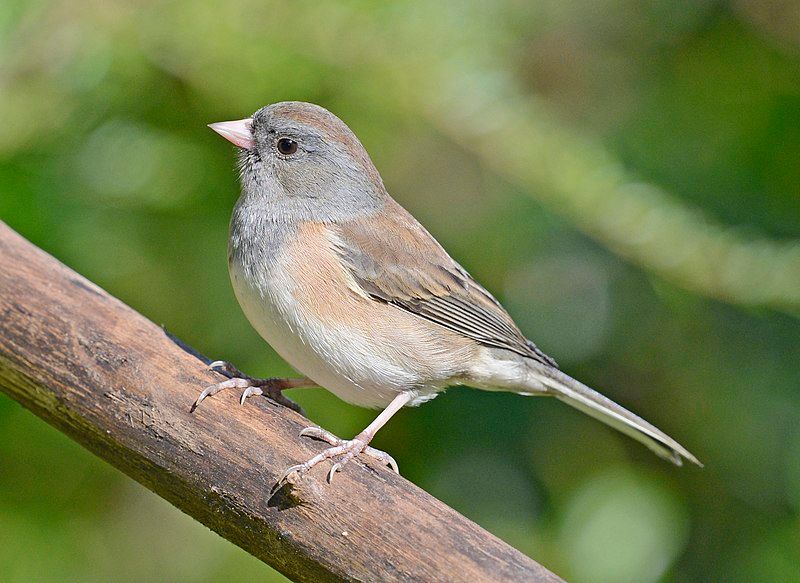
The dark-eyed junco is a small, grayish bird species found in the New World. These birds are common in many parts of North America, from temperate regions to the Arctic during summer.
The dark-eyed junco is quite a variable species, similar in appearance to the fox sparrow. Despite its widespread occurrence, the species’ exact taxonomy is still not fully understood.
These birds have various subspecies, many of which vary in appearance due to their geographic location. For example, some subspecies of the dark-eyed junco are more brightly colored than others.
They also vary in size, shape, and behavior. The dark-eyed junco is most commonly found in forested areas but can also be found in open woodlands, fields, and near human settlements. These birds feed on insects, fruit, and seeds.
Breeding usually occurs from April to August, depending on the subspecies.
The male and female birds build the nest together, and the female incubates the eggs. The dark-eyed junco is an essential species for birdwatchers, as it is one of the few New World sparrows that is relatively easy to identify.
It is also an important food source for many predators, such as hawks, owls, and foxes. As a result, these birds play an important role in maintaining the ecological balance of their habitats.
| Kingdom | Animalia |
| Phylum | Chordata |
| Class | Aves |
| Order | Passeriformes |
| Family | Passerellidae |
| Genus | Junco |
| Species | J. hyemalis |
19. Red-winged Blackbird
The red-winged blackbird is a type of bird that belongs to the Icteridae family. It is found in large parts of North America and Central America. This bird species is a passerine, meaning it has a solid, powerful beak and short legs.
They are usually around 8 to 9 inches long and have a wingspan of up to 18 inches. They have an unmistakable coloration, with their wings and tail feathers glossy black, while the shoulders are a bright red.
The male of the species has an even brighter red color on their shoulders and a yellow band on their wings. Red-winged blackbirds are commonly found near wetlands, streams, and marshes. They are also known to inhabit grasslands, meadows, and agricultural fields.
They are omnivores, meaning they will feed on plant and animal matter, but most of their diet consists of insects, seeds, and grains. During the breeding season, they are known for their loud and melodic calls, which can be heard from up to a mile away.
The red-winged blackbird is a fascinating species to observe and is an integral part of the North American and Central American ecosystems. It is a beautiful sight with its glossy black feathers and bright red shoulders.
They are also highly adaptable and can live in various habitats, making them a common sight in many parts of the region.
| Kingdom | Animalia |
| Phylum | Chordata |
| Class | Aves |
| Order | Passeriformes |
| Family | Icteridae |
| Genus | Agelaius |
| Species | A. phoeniceus |
20. Eurasian Teal
The Eurasian teal is a small dabbling duck found in temperate areas of Europe and Siberia. It is often referred to as the common teal or Eurasian green-winged teal.
This duck species is widespread and can be easily recognized by its distinct green and brown feathers. During the warmer months, the Eurasian teal breeds in northern areas of Europe and Siberia. In the colder months, this species migrates south to warmer climates.
Due to its wide range, the Eurasian teal is often referred to simply as the teal since it is the most common of the small dabbling ducks in much of its range.
The Eurasian teal is an essential species for hunters and birdwatchers and an important part of many wetland and grassland ecosystems.
| Kingdom | Animalia |
| Phylum | Chordata |
| Class | Aves |
| Order | Anseriformes |
| Family | Anatidae |
| Genus | Anas |
| Species | A. crecca |
21. White-crowned Sparrow
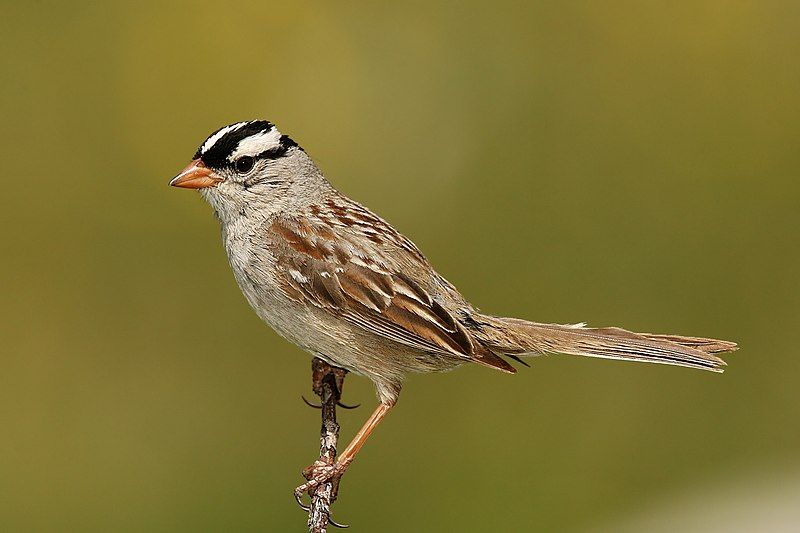
The white-crowned sparrow is a bird species belonging to the passerine family. Native to North America, it is a medium-sized New World sparrow family member. This bird has a grey face marked by distinctive black and white streaking on the upper head.
This streaking pattern is unique to the white-crowned sparrow and helps to identify it among other birds in the area. The white-crowned sparrow is usually found in open woodlands, brush, and grasslands. It is an omnivore, meaning that it eats both plants and animals.
Its preferred foods are insects, seeds, and berries. It also likes to eat grains and often visits bird feeders for a snack. The white-crowned sparrow is a common sight throughout North America and is a beautiful bird to observe.
| Kingdom | Animalia |
| Phylum | Chordata |
| Class | Aves |
| Order | Passeriformes |
| Family | Passerellidae |
| Genus | Zonotrichia |
| Species | Z. leucophrys |
22. Ruby-crowned Kinglet
The ruby-crowned kinglet is a tiny bird that is found in North America. It belongs to the kinglet family, which comprises various small species. Its plumage is olive-green, with two white wing bars and a white eye ring.
The most distinctive feature of this bird is the red crown patch on the male, which is usually hidden under the feathers. This patch is the source of its name, ruby-crowned kinglet.
Birds are an essential part of the ecosystem, as they help scatter seeds and spread pollen, ensuring the health of many trees and plants.
Its small size and bright colors make it a delightful creature to observe in the wild, and it often forages for food among branches and foliage.
| Kingdom | Animalia |
| Phylum | Chordata |
| Class | Aves |
| Order | Passeriformes |
| Family | Regulidae |
| Genus | Corthylio |
| Species | C. calendula |
23. American Widgeon
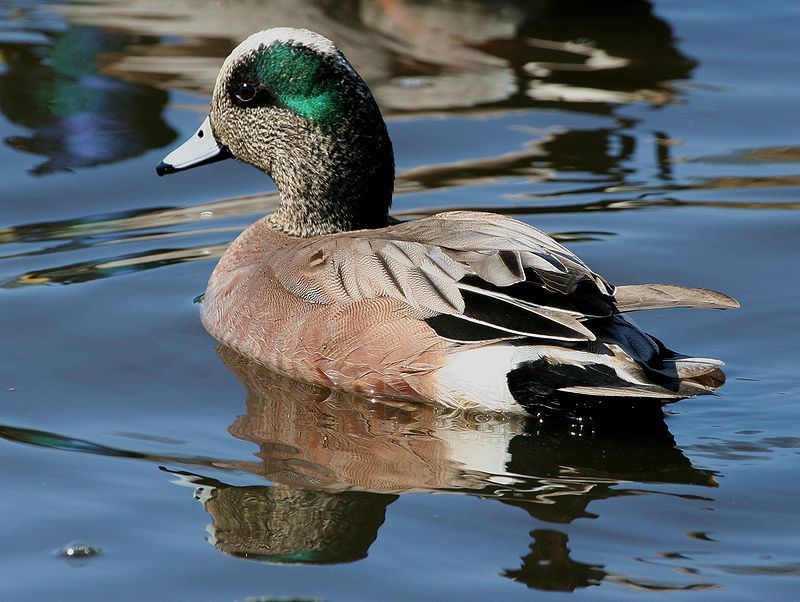
The American wigeon is a species of dabbling duck native to North America. It is also known as the baldpate and was formerly grouped into the genus Anas. However, due to its similarities to other wigeon species, it is now classified in the dabbling duck genus Mareca.
The American wigeon is the New World counterpart of the Eurasian wigeon, a species of dabbling duck found in Europe and Asia. The American wigeon can be distinguished from the Eurasian wigeon by its distinctive white crown and grayish-brown body.
They have a long, pointed bill and mainly eat plant matter. American wigeons are migratory birds, traveling from breeding grounds in the north to wintering grounds in the south. They are often seen in large flocks along wetlands and marshes.
| Kingdom | Animalia |
| Phylum | Chordata |
| Class | Aves |
| Order | Anseriformes |
| Family | Anatidae |
| Genus | Mareca |
| Species | M. americana |
24. Cinnamon Teal
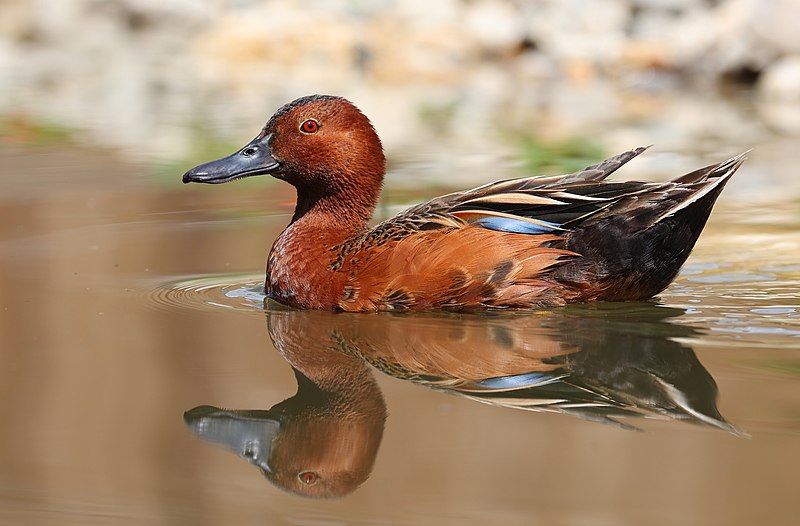
The cinnamon teal is a species of duck found in western North and South America. It is a small duck, typically only measuring up to 17 inches long and weighing around 12 ounces.
This species is easily identifiable due to the bright, reddish plumage of the male and the dull, brown plumage of the female. The cinnamon teal is typically found living in marshes and ponds. It feeds mainly on plants, such as seeds, leaves, and stems.
It will also eat insects from time to time. This species is mainly a dabbling duck, meaning it feeds by tipping itself forward and scooping food from the water’s surface with its beak. The cinnamon teal is a social species often found in large flocks.
This species will also often travel and feed in mixed flocks with other duck species. It is also known to migrate from its breeding grounds in the summer to its wintering grounds in the winter.
Overall, the cinnamon teal is a beautiful species of duck found distributed throughout western North and South America. It is a small, colorful duck that lives in marshes and ponds and feeds on plants and insects.
| Kingdom | Animalia |
| Phylum | Chordata |
| Class | Aves |
| Order | Anseriformes |
| Family | Anatidae |
| Genus | Spatula |
| Species | S. cyanoptera |
Conclusion
Birds in the North West are a diverse and vibrant part of our ecosystems, offering various species, habitats, and behaviors to explore and appreciate.
Bird watching in the region is a popular pastime and provides an excellent opportunity to explore nature and observe the beauty of our avian neighbors.
Whether you’re a novice or an experienced birder, the North West has something to offer everyone.